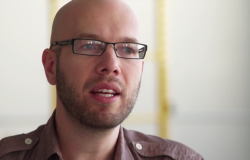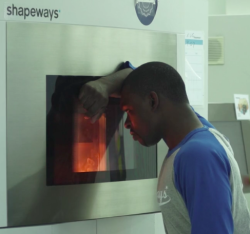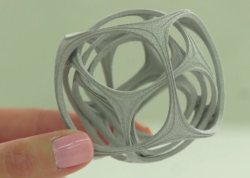Blog
Jan '16 | Telling Complex Stories on a Startup Budget
A Video Production Case Study
San Francisco Video Production Company helps New York 3D Manufacturer Shape Their Story.
The Customer | Shapeways is the world’s largest online 3D Printing Service, Community and Marketplace.
The Need | An Educational Video Series that took designers behind the scenes of the production process, introducing them to the nuances of Shapeways different materials, in order to help designers 3D model more effectively.
Project Goals | Getting Specific
“Shapeways has an extremely complex story to tell and we had very lofty goals of telling it both educationally and inspirationally.” ~ Jeanne Hwang Lam, Marketing, Shapeways
But before we knew how to inspire, we had to step back and outline the three different facets of the company story –Manufacturer, Community, Marketplace – and find the goal within each facet.
- Manufacturer Focused: To provide several tactical tips and tricks applicable to 3D modeling in Shapeways various materials
- Community Focused: To put a face to the Shapeways brand and encourage designers to reach out should they need help
- Marketplace Focused: To inspire designers to push boundaries on their own designs, upload their creations, and sell them on the Shapeways platform.
Once we knew the goals, then we could determine inspiring ways in which to deliver the content.
The Challenges | Complex Story, Startup Budget
But how do you distill a complex company story into a few easily digestible videos, while leaving your audience inspired– all on a shoestring budget?
How We Discovered the Story
Start With What You Can’t Do | Before Patina Pictures
Before you can crack the code on how best to tell a story, sometimes it’s good to start with what you can’t do.
Before contracting with SF Video Production Company Patina Pictures, Shapeways did a series of videos that wowed and inspired but left designers daunted with the process: I’d like to sell my objects, but how do I get started?
Our challenge was to build on their previous excitement, yet outline a few basic steps that would allow designers to start 3D modeling. At the same time, we wanted to instill trust within the designers that the Shapeways Community would help them through the design process, as well as guide them through the best practices when selling on the Marketplace platform.
Study the Competition | Build Upon What They’re Doing Well
The Do It Yourself (DIY) community is a booming new industry that has found a way to successfully educate and inspire new makers, yet their filming style remains simple. Documentary Style. No fancy light sets ups, locations, or camera angles necessary. They make it a point to break down the boundary between spokesperson and audience.
Much like the DIY spokespeople, we knew that an element of our story had to include breaking down the Shapeways company walls, showcasing their staff as fellow designers eager to share their tips and tricks with others.
But unlike the DIY videos, we knew Shapeways employees couldn’t tell the story alone. We knew we needed to tap into the designers that were successfully selling objects within the Shapeways Marketplace, and get their testimonial.
Define Your Audience | Know What & Who Inspires Them
 Once we had our filming style, we circled back to our original goals and determined the best spokesperson to represent each of the company facets.
Once we had our filming style, we circled back to our original goals and determined the best spokesperson to represent each of the company facets.
- Manufacturer Spokesperson: A Shapeways design expert
- Community Spokesperson: A Shapeways design support individual
- Marketplace Spokesperson: A customer of Shapeways, a designer who has successfully sold objects on their Marketplace
Ask Open Ended Questions | Listen for Common Themes
In order to get interesting answers, you have to start with the right questions. After working with the marketing team, Patina Pictures resident video producer K’Dee Miller set off to conduct preliminary interviews in order to discover the commonality within each individual’s story.
“It was overwhelming to think about the storyline, logistics, and production across our own employees as well as designers we wanted to feature. K’Dee worked with us from the very beginning, helping us refine our story and vision, and worked with each individual to craft that story – by the end of the shoot, we all treated her like she worked for Shapeways.” ~ Jeanne Hwang Lam, Marketing, Shapeways

Understand Your Talking Points | Assign Them Appropriately
A common theme that came up in our interviews among Shapeways employees was the necessary iteration process when designing 3D objects. No one gets it right on the first try. But having Shapeways employees discuss this reality could’ve come off negatively. Therefore we added a question for our designers: Tell us about your first design, and how that process shaped your current design process.
Shape the Script | Yet Keep it Loose
Keeping with the documentary form, we transcribed our preliminary questions and answers, then shaped the script from that. Yet instead of handing scripted answers to our subjects for them to memorize, we provided a set of final questions and encouraged certain talking points by saying: We loved it when you talked about this aspect.
That kept our interviews fresh, yet on point.
Discover the Story | Then Define Parameters & Budgets
If you’re like Shapeways and have a complex storyline to sort through before getting into production, we suggest breaking the process up. Start with design, then once that’s successfully accomplished, move into production. The design process determines the success of the entire project, yet in terms of budget, it’s the smallest line item. Once you start getting into production and post-production, that’s when the bulk of the budget is spent. So it makes sense financially to really work on the creative, taking time to discover and design the exact story that you want to tell.
However, that doesn’t mean we enter into a design process without having a broad stroke discussion on production financials. In order to make sure we design your project to scale, we suggest starting with the following:

- Pick a few examples that you want your video to resemble, these examples should reflect
- Filming styles that you’re drawn to; what is the camera doing?
- Narrative styles that you connect with; who is telling the story and how are they doing it?
- Length of video; typically 30 seconds or under, 90 seconds, or 2-3 minutes.
- In-house resources that you plan to incorporate; locations, talent, visuals, props, etc.
- Using the above, a high level discussion on budget can unfold
- Using that estimated number, a design process can be determined that is specific to that number
The Results | How We Got It Done
After successful completion of our design process, we determined the following five deliverables and assigned a set of spokespeople to each video:
- How a 3D Object Gets Made: A high level overview of 3D manufacturing process once a design has been submitted to Shapeways
- Drill Down on Sandstone: Pros and cons of designing with sandstone
- Drill Down on FUD: Pros and cons of designing with Frosted Ultra Plastic
- Drill Down on Metals: Pros and cons of designing with cast metals
- Drill Down on WSF: Pros and cons of designing with White, Strong, Plastic
Then, in order to keep costs down, we scheduled all of our interviews into three days, and our b-roll into two. And because this San Francisco video production company makes it a habit to add value wherever we can, we found room in the production schedule to film an additional series of demos at a fraction of the cost.
Interested in how we did that? Sign up for our newsletter below to receive additional tips and tricks on video production.
Categorized under: Video Production Case Studies
